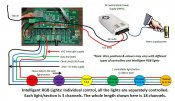toodle_pipsky said:With polarity I meant . . . and I hope I'm explaining it right . . . does it matter which side the data/power goes in? Can you tell if it's meant to go in on particular side or the other, or does it even matter?
Yes this is also important as there is a data in and data out and with the pixels that have the clock wire the same applies, clock in and clock out. It doesnt matter which way the voltage is supplied. So you must ensure the pixel is correctly connected to eachother for the data to be passed on from one to the other.
So when you cut these then i would ensure you mark the input and output sides so you will not get confused.



